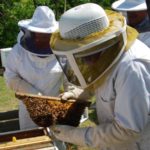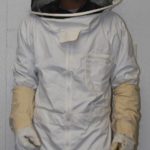
If you are looking to get started with beekeeping and do not yet have equipment, here are the tools you’ll need:
- Hive Tool — This is a small, steel pry-bar. Because bees are always producing wax and always waxing the inside of their hive, the parts of the hive get stuck together by the wax. In the winter, I’ve had Langstroth hives waxed together so well that you could pick up the hive by the lid, and the entire hive would come up in one piece, and these hives weren’t light. The hive tool is what you use to pry the parts of the hive apart so that you can work on and inspect the hive.
- Smoker — The smoker is a metal cannister you can fill with wood chips, grass and leaves then ignite. It makes smoke in a controlled way. Whenever bees sense that something is coming to their hive (such as a bear or a beekeeper), they react by putting out an alarm pheromone–a scent that tells all the bees: “Danger is present.” The smoke masks, or covers up, this alarm pheromone. When getting ready to look inside a hive, I always use a smoker, even at times when you could get by without it, because it keeps the bees calm, and that makes it safer–both for them and you.
- Cap and Veil — The veil protects you from getting stung on the face and neck. Some beekeepers go without any protective gear, but it’s safer to wear it. In my classes, I always ask students to please wear a veil.
- Suit — The suit is not essential. I don’t wear one, but many beginning beekeepers will feel more comfortable around their bees if they do. It’s basically a set of coveralls with a zipper front. Just be aware that it’s not foolproof–you can occasionally get stung, even with a suit, veil and gloves on.
- Gloves — Beekeeper’s gloves are usually made of leather and cloth. They protect your hands and extend up to the forearm so that if you’re wearing long sleeves, which I recommend, they’ll cover the end of your sleeve well, so that bees don’t crawl in.
- Bee Brush — When inspecting the combs or harvesting the honey, you can use this brush to gently brush the bees off the comb.
In terms of cost, most of these tools are fairly inexpensive. Smokers will run about $30-40, a veil and cap together are about $22, gloves are around $15 and a bee brush is under $5. After you’ve gotten a hive, which you can purchase or build yourself, the bees are the biggest expense. A 3 pound package of bees, which is a good size to start with, runs about $110-130. Altogether, you should be able to start your first hive for under $400.
You can click any photo in the gallery below to see a larger view.
Learn More about Beekeeping
To learn more, see our online beekeeping videos or see our classes on beekeeping and other agricultural skills.







I have wanted to have a beekeeping set up since I was in high school. I have thought about doing it here but would only be able to get the hive about a hundred feet from the house and which would be very close to the garden. I don’t know if that would be a problem, but I would rather not have bees buzzing me every time I am in the yard or garden. What do you think?
Thanks,
Dave
Dave, it’s good to hear that you are interested in keeping bees. Honeybees are important for the garden because they are needed for pollination. There are a number of different types of pollinators, but honeybees are one of the most effective.
I know several beekeepers who have beehives in their gardens and don’t seem to mind the bees. I personally have hives 75 feet from my front door, and I haven’t had any trouble with them. Bees don’t generally sting unless the hive is threatened, or they may sting if you happen to get in their flyway to and from the hive. There are guard bees at the entrances of the hives that guard the hives against anything that would try to enter.
The main thing we need to do is create a visual barrier between your activities and the entrances of the hives. You can do that by placing your hive behind shrubs or trees to create a natural screen. You could also build a lattice and plant honeysuckle on it. The bees would enjoy the nectar from the flowers.
It’s also good to place your hive in the shade because direct sunlight can cause it to get too hot.
—
Jake Klingensmith
I’m fairly confident my small 5-acre plot (& surrounding area) can sustain a hive, even though there is no abundance of legumes or flowering plants.
I have an alternative location — a vineyard which is coming into its second year. 2.5 acres are planted and there’s a total of 10 acres which have been prepared.
Which would be your preference?
Looking forward to the 3-30 workshop.
When looking at a good location for your hive, I would consider a couple of things. The first thing would be shade. Afternoon shade can help the bees keep the hive cool in the warm summer days. The combs inside the hive are very fragile, and if the hive should become too warm, the combs can melt. The second thing to consider would be the type of activities around the hive, such as lawn mowers and any loud equipment. At the entrance of the hive stands some guard bees. These bees are watching for any thing that may try to threaten the hive. Noise can get the bees a little excited. It would be good to have some kind of visual barrier in front of the hive to block their vision. This can be done by placing the hive behind some shrubs or you can build a lattice in front of the hive. On this lattice you could plant some honeysuckle. The bees enjoy the nectar honeysuckle flowers produce.
Bees will fly two or more miles from the hive to find nectar and pollen from flowers. I would look within the two miles to see what is blooming to determine were to put my hive. There are beekeepers in many different places, including the city, that make a nice crop of honey. It seems that bees can survive in most any place that has some sort of flowering vegetation.
To answer your question, I think the vineyard sounds like a good place.
Thank you,
Jake Klingensmith
Took the Beekeeping 1 course today and I couldn’t be happier!!!!!!!!! Although I think I will wait until next year to start our bees (have way too many irons in the fire right now) I gained tremendous insight and information. Many thanks to Jake for an excellent class!!!!!!!!
I have several questions because my main intent is to pollinate my field of alfalfa.
1) How much honey can a hive produce in a year?
2) Should it be emptied more than once a year?
3) Which seasons are recommended for emptying?
4) Is emptying a hive of honey essential to good maintenance?
5) Should any measures be taken to protect the hive in freezing weather?
Jim,
It is an excellent idea to keep bees for pollination of your field of alfalfa.
1) A beehive can produce from 3 to 7 gallons of honey per year, and may produce up to 10 gallons a year. The amount of honey will vary depending on your region, climate and rainfall.
2) Normally, you would harvest honey as soon as you recognize that the bee hive has extra honey. There is typically one month out of the year when that occurs, and during that month, you would harvest honey several times. When you harvest honey, you never fully empty the hive, but you do remove extra honey for your own use, leaving enough honey in the hive for the bees, themselves, so that the hive remains strong and healthy.
3) The timing for when you would harvest depends on your region and climate. For the health of your bees, it is very important to learn how to maintain and monitor your hives, and as you routinely monitor them, you will learn to recognize the proper time to harvest the honey. Local beekeepers are also be a good source of information.
4) You will always need to leave enough honey in the hive to support the hive, itself, so you would never fully empty the hive. As long as are managing the hive properly, it’s not essential that you harvest honey. You can, and beyond pollination, that is another way you will benefit from keeping the hive. But if you do not want to harvest the honey, you can still maintain a healthy, thriving hive. Learning how to manage the hive is very important. It is not difficult in any sense, but it does require certain skills along with a good understanding of the behavior and the needs of the bees, and that is a large part of what we teach in our beekeeping workshops.
5) In northern states, it is a good practice to wrap the hives. I recommend contacting local beekeepers to find out what they use for wrapping their hives.
I hope this helps to answer your questions.
Thanks very much for this information. I appreciate your prompt and knowledgeable reply. With this information I can more accurately focus on where to go and what to do to complete this project. Thanks again:
Cordially:
Jim H